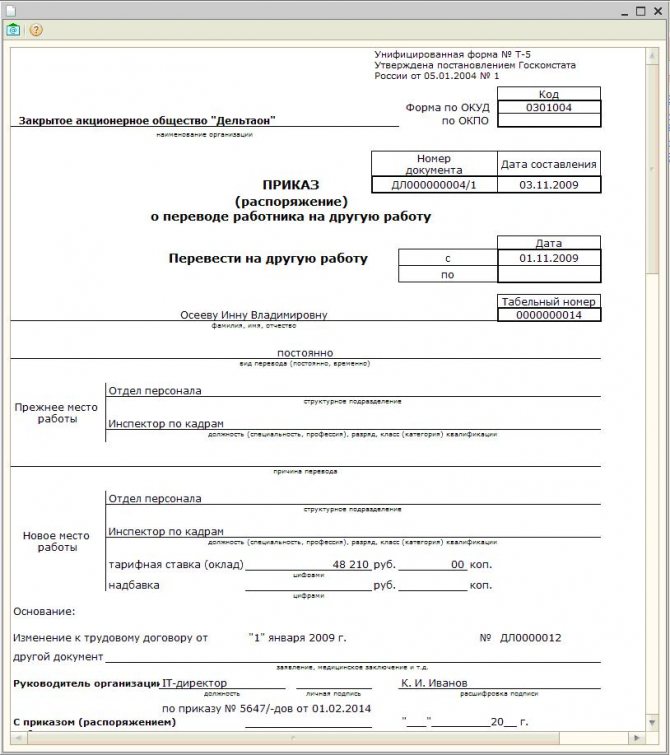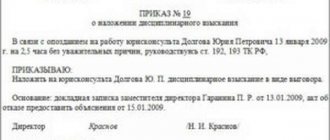The concept of movement according to the Labor Code of the Russian Federation
Under the concept of moving an employee of the Labor Code of the Russian Federation in Part 3 of Art. 72.1 combines several possible actions:
- Changing an employee's workplace. Its definition is given in Art. 209 of the Labor Code of the Russian Federation is a place where an employee must be or where he must arrive in connection with the work function performed and which is controlled by the employer directly or indirectly.
- Transfer of the staff unit in which the employee works to another structural unit. Such a division refers to both separate divisions (branches, representative offices) and others that make up the organizational structure of the enterprise as a whole or a separate division (divisions, sections, workshops). Such a transfer, in order to be recognized as a movement, must be within the same area (within the boundaries of the populated area where the workplace is located).
- Assignment to work on another unit/mechanism.
All of these actions will be recognized as a relocation of the employee only if none of the terms of the employment contract change as a result of their implementation. Moreover, this means any conditions, and not just those that are required to be agreed upon in the text of the contract (Article 57 of the Labor Code of the Russian Federation).
Otherwise, the listed movements of the employee are recognized as changes to the agreed terms of the employment contract, and for their implementation, the Labor Code of the Russian Federation provides for a more complex procedure than for moving an employee (Article 72).
For example, the driver’s employment contract states that he is obliged to work on a specific car (indicating the make, model, etc.). It is not at all necessary to specify such conditions under the Labor Code of the Russian Federation. But an order to perform work on another car will already constitute a change in the terms of the employment contract and will require complicated registration.
Assignment to work in another area
Such a move must be temporary. If it is not planned that the specialist will permanently work in another region, then such a procedure is implemented without his consent.
If it is planned that a citizen will work in another area for a long time, then such movement must be formalized as a transfer. This requires obtaining his written consent to the procedure in advance. Therefore, employers often encounter some difficulties when moving an employee to another structural unit. Hired specialists can go to court, where they will prove that such a process led to a change in the conditions of their work, so the head of the company will be held accountable due to incorrect execution of the transfer.
What is the difference between movement and translation?
Based on the norms of labor law, we can distinguish three main points that distinguish a transfer from a relocation.
The working conditions stipulated in the employment contract change only upon transfer. Transfer is provided for cases where the provisions of the contract remain unchanged .
The employee's job function does not change. The labor function consists of fulfilling a certain list of responsibilities assigned to the employee by the employment contract, as well as local regulations.
The law
does not require the employer to obtain the employee’s consent to the so-called intra-company transfer . The employer must notify his employee in advance about the upcoming changes, but he does not have the right to refuse to work in a new place or in a new structural unit.
Transfer of an employee
A transfer is a change in the labor function of an employee and (or) the structural unit in which he works (if it was specified in the employment contract) while continuing to work for the same employer, as well as a transfer to work in another location together with the employer.
The following types of translation are distinguished:
- permanent transfer to another job (Article 72, 72.1 of the Labor Code of the Russian Federation);
- temporary transfer by agreement of the parties (part 1 of article 72.2 of the Labor Code of the Russian Federation);
- temporary transfer to replace an absent employee (Part 1 of Article 72.2 of the Labor Code of the Russian Federation);
- temporary transfer at the initiative of the employer (part 2, 3 of article 72.2 of the Labor Code of the Russian Federation);
- translation in accordance with a medical report (Article 73 of the Labor Code of the Russian Federation);
- transfer to another location together with the employer (part 1 of article 72.1 of the Labor Code of the Russian Federation).
The labor function, as well as the place of work, are essential terms of the employment contract. Therefore, transfer to another job is permitted only with the written consent of the employee. The exceptions are: emergency situations and downtime (parts 2, 3 of article 72.2 of the Labor Code of the Russian Federation).
The rules on the specifics of regulating the labor of certain categories of workers also provide for other transfer options. Thus, according to Article 254 of the Labor Code, pregnant women, in accordance with a medical report, are temporarily transferred to another job that excludes exposure to adverse production factors, while maintaining earnings from their previous job.
Moving an employee to another structural unit is possible without his consent and is not considered a transfer to another job (provided that the structural unit to which the employee is moving is located in the same area and it is not specified in the employment contract).
Women with children under the age of one and a half years, if it is impossible to perform their previous job, are also subject to temporary transfer at their request to another job with wages for the work performed, but not lower than the average earnings for the previous job until the child reaches the age of one and a half years.
The employer has no right to refuse to make these “special” transfers. The general procedure for documenting an “in-house” translation is shown in the table.
Table. General procedure for documenting “in-house” translation
| Type of transfer | Documenting | |||||
| Employee’s consent to transfer | Additional agreement to the employment contract | Order in form No. T-5 | Entry in the work book | Entry in personal card | Changes in the time sheet | |
| Permanent transfer to another job (including in accordance with a medical certificate) | + | + | + | + | + | + |
| Temporary transfer by agreement of the parties | + | + | + | No | + | + |
| Temporary transfer to replace an absent employee | + | + | + | No | + | + |
| Temporary transfer at the initiative of the employer | No* | + | + | No | + | + |
| Temporary transfer in accordance with a medical report | + | + | + | No | + | + |
| Transfer to another location together with the employer | + | + | + | + | + | + |
* Required only when transferring to a job of lower qualifications.
In cases of temporary transfer, upon termination of its reasons, the employee is given his previous place.
Relocating an employee
Relocation differs from transfer in that it does not entail a change in job function and therefore does not require the employee’s consent.
The movement of an employee without his consent is permitted only insofar as the employee continues to perform the work (labor function) stipulated by the employment contract and no terms of the employment contract established by agreement of the parties are changed. This circumstance was also pointed out by the Constitutional Court of the Russian Federation in its ruling dated June 19, 2007 No. 475-О-О. Despite the fact that his conclusions relate to the norm of Article 72.1 of the Labor Code as amended in force before the entry into force of Federal Law No. 90-FZ of June 30, 2006, they can be taken into account in relation to the current version of the Labor Code. This is due to the fact that the content of the relationship between the parties to the employment contract did not undergo significant changes during the transfer.
Please note that the documents that are drawn up during the transfer are not drawn up when the employee moves. In addition, the relocation of an employee does not entail the employer’s obligation to make appropriate entries in the work book.
The transfer of an employee is unacceptable in a situation where this is contraindicated for health reasons.
The employee is transferred from the same employer to another workplace, to another structural unit located in the same area. Please note that moving an employee to another structural unit is possible without his consent and is not considered a transfer to another job (provided that the structural unit to which the employee is moving is located in the same area and it is not specified in the employment contract).
In this case, as well as during a transfer, it is prohibited to move an employee to a job that is contraindicated for him due to health reasons.
The difference between moving to another workplace or another department and transfer
These two procedures differ in legal consequences and conditions for their implementation.
The term “translation” in the Labor Code of the Russian Federation is used in relation to several different situations (Part 1 of Article 72.1):
- Change in job responsibilities (job function).
- Change of unit when it is specified in the employment contract.
- Transfer to work in another locality (due to a change in the location of the employer or its branch).
The listed situations are united by a common feature - a change in the terms of the employment contract. This is the fundamental difference between displacement and translation.
In addition, a transfer, unlike the relocation of an employee, as a general rule requires the written consent of the employee - an order from the employer alone is not enough (although it will also need to be issued). Moreover, the employee’s will must be expressed by signing the appropriate additional agreement to the employment contract. Involuntary transfer is allowed only temporarily and in exceptional cases - for example, to eliminate the consequences of emergency situations (Article 72.2 of the Labor Code of the Russian Federation).
Kinds
Movement of an employee from one workplace to another . Often, in small companies such transfers are not formalized at all. A person moves to another table or continues to work in another office, and rarely any friction arises with the management of the organization. As for large enterprises and factories, this type of movement may be associated with work in another building, about which the employee must be informed in advance.
Moving to another structural unit . A structural unit can be a department, department, service, or branch of an organization. As you know, such structures are not always located at the same address. In order for an employee’s transfer to another organizational unit, or the so-called “job transfer,” to remain a transfer , such a unit must be located in the same area. By “terrain” we mean the entire territory within the boundaries of a populated area.
A populated area can be a city, an urban settlement, a rural settlement (village, village, hamlet, village). Districts and regions are administrative-territorial entities, not populated areas.
An employee is assigned to work on another unit, mechanism, equipment, and so on . For example, the driver of the organization is assigned a new car, in which he will deliver passengers or cargo in the same way as with the old car. His work function will not change in any way.
The main thing is that such a change in the tool of labor does not contradict the list of job responsibilities established by the employment contract and job description.
In the employment contract, the parties can indicate the structural unit or workplace where the employee will work. In the event that these conditions change, it will not be a displacement, but a transfer.
Types of movement
This procedure is presented in three options:
- moving an employee to another workplace offered within the company where the citizen currently works;
- a specialist moves to another structural unit or branch of the company located in another region or locality;
- the citizen is given the opportunity to work with a new mechanism or unit, which leads to the assignment of slightly different work.
The procedure can be performed even without the permission of the direct employee. Often, relocating an employee is a necessary measure, but the new job must correspond to the specialist’s abilities and experience.
Conditions for movement
The company's management can rearrange (relocate) employees during the work process without changing job responsibilities, working conditions, or area of employment for reasons depending on the production interests of the enterprise and carried out without taking into account the interests of specialists.
Reasons for the procedure may be:
- production necessity, which results in adjustments to the company’s staffing schedule;
- reduction or expansion of the enterprise’s production activities;
- situations of professional and career growth of personnel.
In such situations, the moving employee must follow the orders of the employer or his representatives performing administrative functions at the enterprise.
Important! An employee cannot be transferred to another place of work that is contraindicated for him for reasons related to health. But if the employer did not receive notification of the presence of contraindications, and the employee himself hid such information, then in the future this circumstance may be regarded as an abuse of his right by the worker.
Procedure for registering employee relocation
Important! The employee relocation notification form from ConsultantPlus is available here
The management of the enterprise has the right to move an employee to another structural unit for production or other reasons, including medical indications. In this case, the conditions for the location of the new place of work in the previous area and the absence of significant changes in the labor function (job responsibilities) must be met:
- To reshuffle a specialist, the head of the enterprise issues an appropriate order, which defines a new job or structural unit for the employee to perform job duties.
- The basis for preparing the order is a report (official) note drawn up by the head of the department or structural unit where the specialist works.
- The document is submitted for consideration to the management of the organization, who affixes a conciliatory resolution, the corresponding date and signature.
If the initiative to move to a new place of work comes from an employee, the latter draws up a written application. The text of the document must contain a request to move the applicant to another unit or to another position, indicating the reasons that necessitated such a procedure. The application must be accompanied by supporting documents or medical reports if there are medical indications for moving the worker.
The application is brought to the attention of the management of the enterprise, which, if agreed, issues an authorization visa, which serves as the basis for preparing the appropriate order for the organization.
The text of the order states:
- position held and name of the department or unit where the applicant works;
- grounds for reshuffle;
- name of the unit or position (according to the staffing table) to which the specialist is transferred.
The specialist must familiarize himself with the prepared order and submit his visa for familiarization.
Important! An additional agreement is not drawn up to the employment agreement with the employee, since there is no change in his main job function. An entry about the employee’s movement is not made in the work book (Article 72 of the Labor Code of the Russian Federation).
Relocation order - how to fill out and where to get a sample
To move an employee, it is enough for the employer to issue an administrative document, for example an order. There is no need to ask the employee for consent. There is no standardized form for a movement order, so it should be issued in free form.
We recommend following the following rules when drawing up an order:
- Typically, orders are issued on company letterhead (if available at the enterprise). Mandatory details of orders are date, serial number and name.
- The order consists of a preamble and a main part. The preamble should refer to the document in connection with which the transfer is being made (if any), and also indicate that the terms of the employment contract do not change.
- The order must be signed by an authorized person: without a power of attorney - by the head of the organization or another employee, if his ability to sign such documents without it is provided for by the charter; or by any person with the appropriate power of attorney.
- The order should provide a place for the employee in respect of whom the order is issued to mark familiarization.
A sample relocation order can be found on our website.
The order to move an employee must be brought to the attention of the latter against receipt. If he refuses to sign for familiarization, then this should be recorded in the order itself, attesting to the fact of refusal with the signatures of several witnesses.
A worker’s refusal to comply with an order to move can be regarded as a disciplinary offense (determination of the RF Armed Forces dated June 18, 2010 No. 25-B10-3).
Horizontal relocation to another office - what rules are provided by the Labor Code of the Russian Federation?
As can be seen from the above, an action such as changing a structural unit may in one case qualify as a transfer, and in another - as a relocation of an employee .
Many employers have not one, but several offices in the territory of one locality (which may or may not have the status of separate divisions). And when the need arises to move an employee to another office, the following situation is possible: the employee does not agree with the move and refuses to go to work at the new address. The legality of such a refusal depends on specific circumstances:
- The employment contract specifies the structural unit. This means that translation rules apply. This means that an employee has every right to refuse to go to work in another office, and he cannot be punished for this (decision of the Moscow Regional Court dated June 15, 2010 in case No. 33-11570, determination of the Moscow City Court dated April 16, 2012 in case No. 33-9062).
- The employment contract does not contain information about the unit. In this case, the employee’s consent to work in another office is not required, and for failure to comply with the order to move, he can be brought to disciplinary liability in accordance with Art. 193 Labor Code of the Russian Federation.
Should the structural unit be indicated in the employment contract?
Thus, the need for the employee’s written consent depends on whether the structural unit is indicated in the employment contract. It will be much more convenient for an employer to make personnel movements if the employment contracts do not include information about the specific department where the employee is to work. It is enough to indicate the locality as the place of work.
But let us recall that, according to para. 2 hours 2 tbsp. 57 of the Labor Code of the Russian Federation, when hiring for a separate unit (for example, a branch or representative office), which is located in a locality other than the parent organization, it is mandatory to indicate the unit and its address in the text of the employment contract. Accordingly, such employees can be transferred to an office at a different address only with their consent.
And, even if the structural unit is not specified in the contract, you need to answer the question: will at least one of its conditions change when moving to another office? For example, a change in work mode or job responsibilities is possible. If the answer to this question is positive, it is impossible to do without obtaining the worker’s consent and concluding an agreement with him.
Thus, the court declared the transfer of an employee to another office illegal, since as a result of this action he had an additional obligation (appeal ruling of the Supreme Court of the Republic of Tatarstan dated September 13, 2012 in case No. 33-9332/2012).
Documentation rules
The relocation of an employee must be accompanied by the preparation of certain documentation by the employer. There must initially be a basis for this. It is represented by a decision of the head of the company or a memo received from a direct employee of the company.
To formalize the process, it is enough to issue an order in free form. When drawing up an order to move an employee, the following points are taken into account:
- if a translation is performed, then a unified T-5 form is required;
- it is allowed to use this form even for movement;
- each company has the right to develop its own unique form, which is then competently approved by management;
- the order may be replaced by a notice of relocation or a special written order drawn up by the director of the company;
- there is no need to draw up any additional agreements to the existing employment agreement;
- Various notes are not entered into the employee’s work book or personal card.
The Labor Code does not have any clear requirements for formalizing the process of movement of a company employee. Therefore, usually this procedure is clearly established by company managers at the local level. Most often, information is included in labor regulations. In this case, you can prevent various conflicts with hired specialists. If employees refuse to move without justified reasons, then penalties may be applied to them as part of disciplinary liability.

Legal consequences of moving or refusing it
The management of the organization has the right to make any personnel changes aimed at increasing the rational use of property and the efficiency of the enterprise. Each specialist is obliged to comply with the employer’s decision to relocate him.
Refusal to execute a transfer order is equivalent to a disciplinary violation on the part of the worker (Article 192 of the Labor Code of the Russian Federation).
ATTENTION! In case of substitution of concepts and registration under the guise of transfer without the knowledge and consent of the employee of his actual transfer (with a change in working conditions), the management of the organization may face punishment.
If an employee refuses to perform official duties during his illegal reshuffle, in accordance with the law, his labor rights remain unchanged (Article 81, 379 of the Labor Code of the Russian Federation). In this case, the employee cannot be subject to disciplinary liability. The employer also cannot prevent the employee from protecting his own labor rights (Article 380 of the Labor Code of the Russian Federation).
If the transfer is declared illegal by the court, an employee may file a claim for payment of the difference in earnings (for the period of performing other work), for payment for forced absence time, for compensation for moral damage caused to him (Article 236 of the Labor Code of the Russian Federation).
The transfer order was sent by mail, but the employee did not receive it. The court did not regard failure to show up for work as absenteeism and indicated that in this case, dismissal was a disproportionate punishment. The employee was reinstated.








